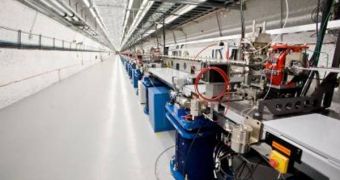The Stanford University's SLAC National Accelerator Laboratory can now, after years of planning and construction, finally boast the world's largest X-ray laser. Dubbed the Linac Coherent Light Source (LCLS), the instrument will offer scientists the ability to peer deep into the atomic and molecular structure of materials, and also allow them to understand how atoms are arranged inside materials. In the test-runs, the machine has managed to create the fastest and shortest pulses of laser in history, even though just 12 of its planned 33 undulator magnets have been installed.
“This is the most difficult light source that has ever been turned on. It's on the boundary between the impossible and possible, and within two hours of start-up these guys had it right on,” John Galayda, the Construction Project director at the LCLS, said. “This milestone establishes proof-of-concept for this incredible machine, the first of its kind. The LCLS team overcame unprecedented technical challenges to make this happen, and their work will enable frontier research in a host of fields. For some disciplines, this tool will be as important to the future as the microscope has been to the past,” Persis Drell, the director of SLAC, added.
Overall, the machine is about a mile long, and its powerful generators create lasers made from X-rays, rather than visible light. The applications for this type of technology far exceed the possibilities that its visible-light counterpart has, in terms of depth of field and the clarity of the details that can be resolved. The generated pulses are so strong and so brief, that specially deigned, stop-motion cameras have had to be installed just to capture them and their effects on the targets. At first, operations will be focused on exploring the atomic arrangements found in metals, semiconductors, ceramics, polymers and proteins, in a chain of studies that will considerably further science.
“The LCLS team saw a vision of a remarkable new tool for science that could be achieved by using the existing SLAC linear accelerator, and they delivered on that vision with remarkable speed and precision. The science that will come from the LCLS will be as astounding and as unexpected as was the science that came from the lasers of a few decades ago. We do not yet know all that the LCLS will reveal about the world around us. But we can be sure that the new results will excite and energize the scientific communities that we serve,” Patricia Dehmer, the acting director of the DOE Office of Science, shared in a press release on SLAC's webpage.

 14 DAY TRIAL //
14 DAY TRIAL //